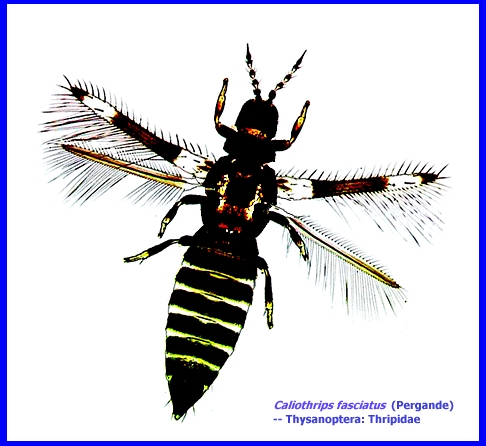File: ch-138.htm GENERAL INDEX [Navigate
to MAIN
MENU ]
Link
to: <UC-Biocontrol>
|
NORTH AMERICAN BEAN THRIPS Caliothrips
fasciatus (Pergande) -- Thysanoptera, Thripidae ----- CLICK on Photo to enlarge
& search for Subject Matter with Ctrl/F. GO TO ALL: Bio-Control Cases
Economic Damage
Economic damage is caused by direct
feeding injury by thrips larvae and adults. Bailey (1933) notes that larvae
are responsible for more feeding damage than adults as they tend to be numerically
superior on host plants, they are less active which results in larval feeding
being limited to confined areas, and larvae tend to feed gregariously.
Feeding damage is manifested as silvering on leaves, and when feeding damage
is heavy, premature defoliation can occur. This has been observed for heavily
infested pear trees and following defoliation events new growth and immature
fruit are subjected to “sun-scald” over summer and the tree productivity is
not as vigorous the following season (Bailey 1933). In the absence of leaves,
thrips will feed on immature fruit which results in scarring and downgrading
at packinghouses. Bailey (1933) notes that in once instance up to 15% of pear
fruit were damaged at an orchard in the Berryesa Valley, Napa County
California in 1930. Additional cosmetic damage results from the deposition of
black fecal droplets on fruit surfaces by feeding larvae and adult thrips. Bean thrips adults have been recorded
from a very large and diverse variety of plants (Table 1). Many potential
feeding and breeding hosts are common weeds (e.g., prickly lettuce, Lactuca
serriola) and native California plants that may be found in
or around citrus orchards. Thrips are notoriously poor fliers and Bailey
(1933) states that bean thrips are capable of only flying about 1-1.5 meters
(3-4 feet) in a zig-zag or spiral pattern before landing. The pattern of
dispersal in the field is irregular and is dependent on the direction and
strength of the wind and the location of the source infestation (Bailey
1933). Because bean thrips are poor fliers incapable of controlled linear
flight over long distances an effective cultural control practice to reduce
the likelihood of adults reaching fruit to overwinter in may be good weed
sanitation in orchards. Bean thrips infesting weeds on the orchard floor in
close proximity to trees bearing fruit may simply need to fly a couple of
feet to find overwintering sites (Figure 3). Weeding would remove potential
host plants located within orchards, which are sometimes immediately under
fruit bearing trees. Controlling weeds within 10-20 meters (30-60 feet or
further from the boundary) of orchard margins could reduce migration rates
into orchards and subsequent contamination of fruit in border rows. Orchards
that have poor weed management tend to have high levels of bean thrips
activity (Bailey 1933). Conclusions
Bean thrips contamination of
California-grown navel oranges and increasingly mandarins with navels that
are exported is a perennial quarantine problem for citrus growers. There are
no reliable reports of bean thrips having established populations outside of
North America, the assumed native range. Consequently, there are no records
of this thrips being a pest anywhere else in the world. In this regard, bean
thrips appears to be a pest unique to California (and possibly a few other
western states, like Idaho and Utah [Bailey 1937]) but only during the
1930’s. It is uncertain as to why bean thrips is no longer a significant
agricultural pest in California (or elsewhere). One possible reason as to why
bean thrips has failed to establish in countries receiving California citrus
contaminated with bean thrips is because thrips have been debilitated by
cumulative cold stresses that significantly reduces the fitness of survivors.
The ability of bean thrips to form overwintering aggregations inside navels
may be mediated by a male-produced aggregation pheromone. Elucidation of a
male-produced aggregation pheromone could provide novel detection and control
tools. The severity of bean thrips infestations of citrus fruit fluctuates
from year to year, and annual variation may be driven, in part, by weed
abundance which is affected by winter rainfalls and irrigation. Good weed
abatement may reduce infestation risks to California citrus growers and
subsequently lessen risks of shipment rejections at ports of entry. REFERENCES: [Additional references may be found at: MELVYL Library ] Bailey, S. F. 1933.
The biology of the bean thrips.
Hilgardia 7: 467–522. Bailey, S. F. 1937.
The Bean Thrips. Monograph
Bulletin 609. University of California Experiment Station, Berkeley,
USA. Bailey, S. F. 1938.
Thrips of economic importance in California. Circular of the
University of California Berkeley Agricultural Experiment Station 346. Harmon, J. A., Mao,
C. X. & Morse, J. G. 2007. Selection of colour sticky trap for
monitoring adult bean thrips, Caliothrips fasciatus
(Thysanoptera: Thripidae). Pest
Management Science 63: 201-216. Hoddle, M. S. 2020.
North American bean thrips: A perennial export problem for California
citrus growers. Citrograph 11(2):
40-43. Hoddle, M. S.;
Stosic, C .D. & Mound, L .A.
2006. Populations of North
American bean thrips, Caliothrips fasciatus
(Pergande) (Thysanoptera: Thripidae: Panchaetothripinae) not detected in
Australia. Australian Journal of
Entomology 45: 122-129. Morse, J. G. 2006.
Management of bean thrips. Citrus
Research Board Annual Report. 3 pp. (last accessed 10 December 2019) Mound, L. A.; Zhang, H.-R & Bei,
Y.-W. 2011. Caliothrips tongi sp. n. (Thysanoptera:
Thripidae) from China and a dubious record of North American bean
thrips. Zootaxa 2736: 57-62. Mound, L. A.;
Nakahara, S.; Tsuda D.M. 2016. Thysanoptera-Terebrantia of the Hawaiian
Islands: an identification manual.
ZooKeys 549: 71–126. Mound L. A.; Hoddle
M. S. & Hastings A. 2019. Thysanoptera Californica - Thrips of
California. Lucidcentral.org, Identic
Pty Ltd, Queensland, Australia. Last accessed 22 October 2019. Wilson, T. H. 1975.
A monograph of the subfamily Panchaetothripinae (Thysanoptera:
Thripidae). Memoirs of the American Entomological Institute 23: 1–354. |
